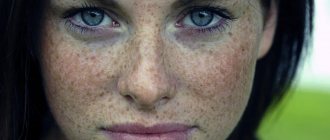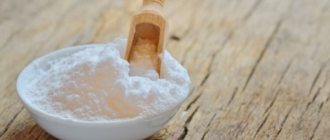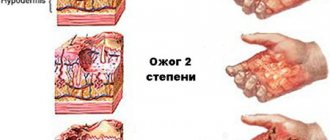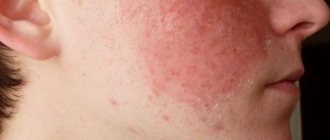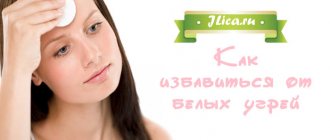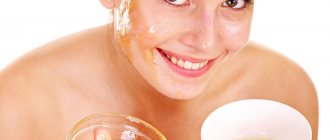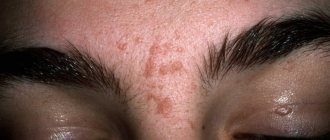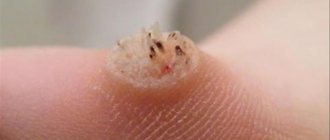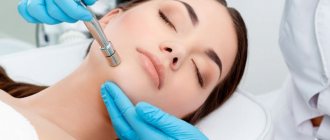Skin resurfacing at home
Grinding, or peeling, involves removing the stratum corneum of the epidermis. Mechanical peeling is carried out using abrasive materials. Suitable for sanding at home:
- crushed shells of nuts, eggs;
- fine crystalline sugar;
- ground coffee;
- fine crystalline sand;
- dried, crushed seaweed;
- soda.
Before trying this or that scrub, you need to exclude the possibility of an allergic reaction. It is best to conduct a skin sensitivity test. If scars from acne or microtraumas appear on the skin of the face, it is necessary to check the sensitivity of the skin.
Important! To prevent skin injury, it is necessary that the abrasive materials be crushed to small particles.
Are there any contraindications and side effects?
Achieving a visually noticeable cosmetic effect requires a procedure in two/three stages. Moreover, the interval between these stages should be from 1 to 3 months (depending on how the skin regeneration proceeds). It is dangerous to use peelings for sensitive and thin skin. Under the influence of acids, her condition can be made even worse. First you need to carefully and accurately do a small test. Checking for allergic reactions before performing a scar removal procedure is also desirable, and even mandatory. All this needs to be clarified before exposing the skin to highly concentrated formulations.
All peels, from the most gentle to the most radical, have a number of contraindications.
Peels for scars: contraindications
Any peeling is a protracted procedure, quite complex, painful and stressful for the body. You should not decide on it when the skin clearly has a tendency to form keloid scars. There is also a certain list of contraindications related to the general condition of the body.
This
- pregnancy and breastfeeding months;
- the presence of benign or malignant tumors;
- heart and vascular diseases, as well as hypertension;
- liver and kidney diseases;
- endocrine disorders and diabetes;
- manifestations of rosacea and rosacea;
- mental illnesses and disorders;
- allergic manifestations to the components of peeling compositions.
Simple scrubs
A mask based on badyagi powder and hydrogen peroxide (3%) gets good reviews. To prepare it, you need to mix the ingredients in 1:1 proportions and wait until foam forms. Apply the mixture pointwise to the surface; if the scars are on the face, avoid the area around the mouth and eyes. You need to hold the mask for at least 20 minutes, moisten the skin with peroxide using a cotton swab, and massage with your fingers for 10 minutes. You need to wash off the composition from the skin with warm running water.
Interesting! After using the scrub, it is better to apply a cream suitable for your facial skin type.
It is recommended to carry out the grinding procedure with badya once a week for 8-9 weeks. This mask whitens, exfoliates and smoothes the skin well. Contraindications to the scrub are dilated capillaries and skin inflammation. The greatest effect is observed in the fight against scars on the skin formed after acne.
The following recipes are also popular in the fight against scars:
- Mask made of sugar with the addition of olive oil. The scrub components must be mixed in 1:1 proportions. Distribute evenly, massage pointwise. The product is not suitable for dry skin.
- Mask based on crushed egg shells, egg yolk, sour cream. Mix in equal quantities. Apply with light rubbing movements, massage for no more than 15 minutes, then rinse with warm water.
To prepare an exfoliating mixture for peeling, you can use abrasive materials by adding essential oils and crushed dried peels of citrus plants. Scrubs are good at smoothing out acne scars and minor injuries. It will not be possible to completely remove large scar defects in this way.
Advice! It is necessary to massage the skin after grinding strictly along the massage lines, so the skin will not stretch and lose elasticity.
Intensive mechanical peeling, scar polishing
This method is quite effective, but unsafe and not entirely pleasant. It can be used to remove scars all over the body.
Using a washcloth, sponge or massage brush, you need to actively massage the area with the scar. The rougher the brush, the more powerful the effect on the skin.
If the scar is on the face, treatment in this way must be carried out very carefully, using a special facial massage brush. It is much softer and will not injure delicate skin as much. A regular soft nail file will also work.
Gommage procedure at home
Gommage is deep resurfacing using various cosmetics, suitable for sensitive, thin, dry skin. This procedure is performed in the salon by professional cosmetologists. If a trip to a cosmetologist is not planned in the near future, you can carry out gommage at home using improvised means.
Gommage mixtures should not contain coarse particles. The mixtures contain chemicals that quickly remove dead skin cells. Can be used:
- fruit acids;
- lactic acids;
- flour of different types;
- zest of citrus plants.
Before starting the procedures, the skin must be steamed, then a pre-prepared mixture must be applied. You need to massage the skin for 8-10 minutes, after which the dead cells can be removed along with the mask.
Mixture options for the gommage procedure:
- For dry skin, you need to mix semolina, oatmeal, chopped orange zest in a ratio of 2:1:1.
- For oily skin, mix rice, barley flour, dry cream in proportions 1:2:1.
The mixtures are prepared in advance, mixed with cream or tonic, milk or kefir immediately before the procedure. If desired, you can add ginger, cinnamon, dried seaweed, and clays of all colors to the mixture.
Acne scars
With the onset of puberty, both boys and girls experience pimples and acne on their faces. Most often they go away on their own, but in many cases they are followed by scars or keloids. It’s easier to deal with them, of course, right away. While the scars are fresh, removing them is much easier.
However, many, especially young men, are embarrassed to seek help from a professional cosmetologist at this age.
In advanced cases, when the scars on the face are already more than one year old, it is impossible to completely cope with the problem. They can be corrected, made smaller and paler, the surface smoothed, but barely noticeable marks will still remain.
Brossage – deep facial peeling
For the brushing procedure, you need a stiff brush made of natural bristles. First, you need to apply a scrub (homemade or purchased) to your face, hold for 5-7 minutes, then use a brush to move along the massage lines.
At the end of the procedure, you need to wash off the composition from the skin with water at room temperature, then apply a napkin soaked in tea, which will relieve irritation. To prepare a scrub at home for the brosage procedure, you can use various abrasive materials, essential oils, and herbal ingredients.
To remove dead cells from the surface of the skin, you can use a 5% calcium chloride solution. Apply the solution to the skin in a thin layer, and after drying, apply another layer. In total, it is necessary to apply from 5 to 7 layers. After the last layer has dried, you need to soap your fingertips with baby soap and rub it over your face. Rinse the composition off the skin with warm or cool water. After peeling, it is better to apply moisturizer.
Facial peeling helps even out skin after acne and acne, and improves skin tone. After grinding, metabolic processes are normalized and regeneration is accelerated.
Which peeling is better to use?
Peels of skin scars can be physical (mechanical), laser (hardware, radiation) or chemical (acid).
- Physical is a superficial peeling based on grinding the top layer of skin with various abrasive compounds such as scrubs. Fine abrasive chips made from materials of both natural and synthetic origin gently polish the top layer of skin and smooth it out. Many people periodically use scrubs on their face when washing their face. Scar peeling is similar to this procedure, but is performed more professionally.
- Laser, hardware peeling for scars and scars includes grinding of the epidermis by irradiation with lasers with a certain wavelength. The doctor adjusts this length, depending on the depth of penetration of scar tissue into the skin and the degree of its oldness. Laser irradiation removes scars gradually, layer by layer. Recent scars and scars from several laser treatments are completely resolved, while old ones remain, but become smoothed and visually invisible.
- From the point of view of the final result, chemical peeling of scars is the most effective type of such correction procedures. It has a deeper effect, capable of affecting not only the middle, but also the deep layers of the skin. In total, modern cosmetology uses more than fifty types of acid compounds for this method of cleansing and smoothing the skin. Popular and well-proven ones are: a composition based on 35...50% trichloroacetic acid TSA; retinoic; glycolic; phenolic compounds. The mechanism of their action is the same: softening of scar tissue, thinning, followed by exfoliation over several procedures.
What do these methods have in common, and which peel is best for eliminating acne scars? All methods are aimed at destroying scar tissue and smoothing the skin. All stimulate the active production of collagen, hyaluronic and elastin fibers, which restore the skin. All have a certain degree of stress on the skin and the body as a whole, and therefore require careful treatment and a rehabilitation period after use.
Masks to remove imperfections
To remove small scars, you can use products and masks that can be prepared from improvised means at home. The following recipes are very popular for acne scars and minor injuries:
- Lemon based mask. Lemon has a strong whitening, anti-inflammatory, and smoothing effect. The main substances in its composition are vitamin C, which improves the production of collagen and elastin, and folic acid, which relieves inflammation.
- Mask with lemon and honey. Mix lemon juice with heated honey in equal proportions. Apply to skin, after a quarter of an hour, rinse with cool water.
- A mask made of clay (suitable for your skin type), lemon juice and egg yolk. Mix a tablespoon of clay with egg yolk, add the juice of half a lemon. Leave the mixture for 10-15 minutes, rinse with water, apply nourishing cream.
Aloe-based masks have proven themselves to be effective in removing imperfections on the face. This plant has regenerating, leveling properties. You need to mix two tablespoons of freshly squeezed aloe juice with a couple of drops of fruit oil, leave for 5 minutes, and then rinse with water at room temperature. If you don’t have time for a mask, you can wipe your face with a slice of lemon or aloe.
Chemical peels for scars
Chemical peels can smooth out only small scars. Superficial peels that affect the stratum corneum of the epidermis will not give any result, since only deep or medium peels will help against scars .
Peeling for scars with trichloroacetic acid (concentration 30-50%). Medium or deep TCA peels for scars are quite effective, but glycolic acid is added to ensure even application and distribution of the drug. To smooth out scarred skin, 3-5 mid-peeling procedures are usually required, which are carried out at intervals of one month. When using deep peeling against scars, you can get by with one procedure, but you should be aware that such peeling requires pain relief and several weeks of subsequent rehabilitation. Learn more about TCA peel.
Phenol peeling. To get rid of scars, deep peeling is used with a composition containing 50% of the active substance. This is a very painful procedure: when treating large areas, it is done in a hospital under general anesthesia. Often the wound surface is covered with a waterproof film, which performs a protective function. The recovery period after chemical phenol peeling against scars takes a lot of time, so it is better to do the procedure during the holidays, and in the autumn-winter period. The last condition is due to the fact that after the procedure it is necessary to carefully protect the skin from sunlight, which can cause hyperpigmentation of young skin. Find out more about phenol peeling.
Lotions and compresses
In order to make a compress, you need to moisten a gauze cloth with a solution or apply a mixture. It is recommended to keep the compress for 30 minutes to 2 hours. For lotions, you can use honey, oatmeal, camphor, vodka with the addition of essential oils or vegetable juices. The ones that have proven themselves best are:
- Compress with honey. If desired, add a few drops of lemon juice to the heated honey, spread the mixture on the affected area, cover with cellophane, then with gauze. Leave for 1.5-2 hours, then rinse off with warm water. Effective against acne scars.
- Compress based on vodka. Moisten a gauze cloth with vodka, apply it to the surface, cover with cellophane and gauze. It is better to leave the compress overnight.
- Compress with camphor oil. Moisten the gauze generously with oil, apply it to the scar, cover it with cellophane, and leave it overnight. Helps remove acne scars.
- Oatmeal based lotion. Mix kefir with oatmeal until a thick paste is obtained, apply the mixture to the tripe, and leave for half an hour. Rinse off with cool water.
It is important to remember that in order to remove acne scars and minor injuries at home, it will take a lot of strength and patience. The first results will be visible only after a few months. To quickly achieve results, you can use several methods of scar removal.
Selecting the required type of peeling
Any scar is primarily a rough connective tissue with a fibrous structure, which was formed as a result of the replacement of ordinary skin cells. Scars that are similar in structure can have different appearances. They may look like bumps protruding above the surface of the skin or, conversely, like depressions.
In the first case, mechanical peeling or grinding based on aluminum oxide, diamond fractions or saline is most often used. In case of deep scars, chemical peeling is used. Laser treatment is considered universal and is suitable for both cases.
How much does scar peeling cost? Price for scar peeling in the salon
The price of scar peeling depends on the size of the defect, the correction method used and the status of the cosmetology establishment. The table shows the approximate cost of destruction of 1 sq. centimeter of scar tissue.
| Peeling name | Type of peeling | Scar peeling price, from |
| TCA peeling | chemical | 600 rubles |
| Phenol peeling | chemical | 700 rubles |
| Laser peeling | hardware | 600 rubles |
| Dermabrasion | hardware | 700 rubles |

